Ukraine in maps: Tracking the war with Russia
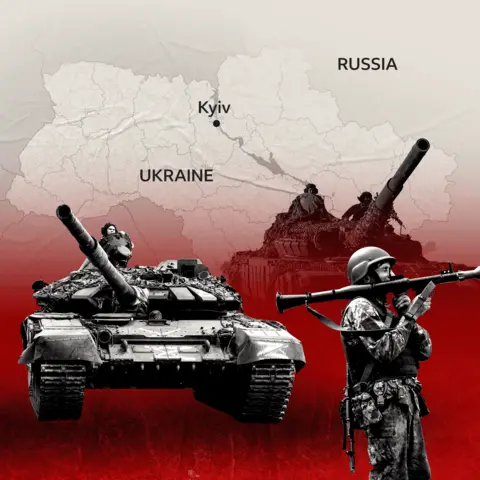 BBC
BBCFighting has raged in Ukraine since Russia launched a full-scale invasion more than three years ago. Russian forces have slowly expanded the amount of territory they control over the past year, mostly in the east of Ukraine, and have in recent weeks launched a barrage of air strikes on Kyiv and other cities.
Here is a recap of recent significant events and the situation in Ukraine.
Russia grinds forward in the east
In eastern Ukraine, Moscow's war machine has been churning mile by mile through the wide open fields of the Luhansk and Donetsk regions, surrounding and overwhelming villages and towns.
It is trying to capture the rest of the region, known as the Donbas, according to US-based analysts at the Institute for the Study of War (ISW), but the front line has barely moved for two years.
Ahead of a Nato summit currently under way in the Netherlands, Russia has significantly increased drone and missile attacks targeting Ukrainian cities including Kyiv and Kharkiv, which have killed several people.
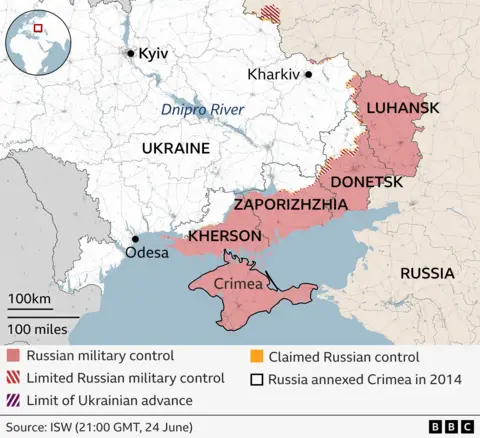
But Russia's biggest advantage is manpower and it has shown a willingness to throw soldiers at Ukrainian positions to gain a few metres at a time - with at least 45,000 Russian troops killed in the past year alone.
Ukrainian military intelligence says about 620,000 Russian soldiers are operating in Ukraine and Kursk. Kyiv believes thousands of troops have entered Ukraine since the start of the year.
- Why did Putin's Russia invade Ukraine?
- How the West is helping Russia to fund its war
- Russia's economy is down but not out
Russian forces have been advancing slowly north and west of Donetsk, towards the city of Pokrovsk, but have faced Ukrainian advances to the west of Toretsk, according to experts at the ISW.
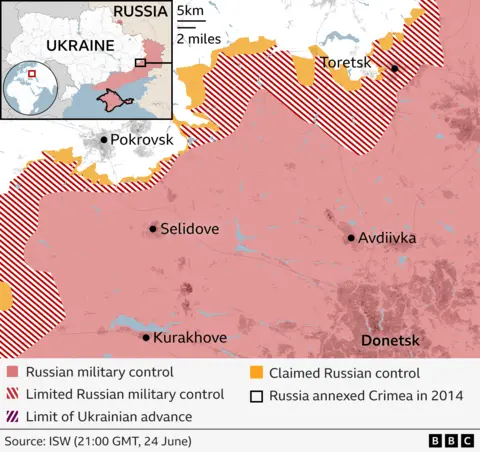
The Russian advance towards Pokrovsk is the most notable change in control of the front line near Donetsk for several months, but analysts say innovative tactics by Ukrainian forces, combining the use of drones and ground forces, have inflicted significant losses of troops and equipment and slowed the offensive.
It has taken more than a year for Russia's troops to advance about 40km (25 miles). Ukraine was forced to withdraw from Avdiivka, just north of Donetsk, in February 2024 after months of fighting.
Russian incursion north of Kharkiv
In addition to its operation on the eastern front, Russia began what the ISW describes as its "subordinate main effort" when it crossed the international border to the north of Ukraine's second-biggest city, Kharkiv, in May 2024. Several villages were seized and thousands of civilians fled.
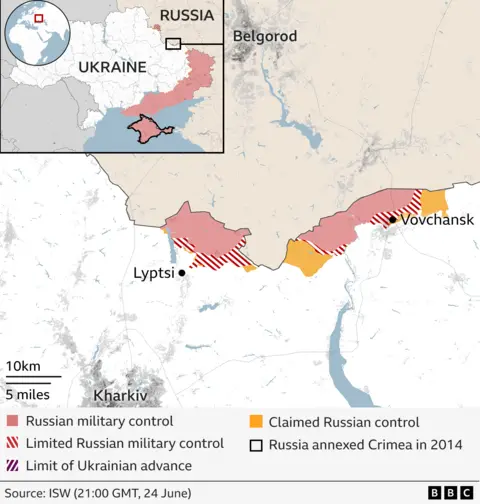
The Russian push took place at the end of a four-month period when the US was not supplying weapons to Ukraine, due to a stalemate in the US Congress which was resolved in April 2024.
Ukrainian forces eventually held firm and, even though the city of Kharkiv has come under repeated attack from glide bombs fired by Russian warplanes, it remains beyond the range of Russian artillery.
Ukraine suggests territory swap
Eastern Ukraine has been contested territory since 2014, when Russian-backed fighters seized large swathes of the eastern Donetsk and Luhansk regions. Russia had already seized the southern peninsula of Crimea in February 2014 before annexing it soon afterwards.
US President Donald Trump has said it is unlikely Ukraine will return to its pre-2014 borders but, in response to a question from the BBC, he said "some of that land will come back".
In an interview with the Guardian, published on 11 February, Ukrainian President Volodymyr Zelensky suggested that Russian-held territory in Ukraine could be swapped for territory seized by Ukraine in Russia's western Kursk region in recent months as part of a peace deal.
Ukraine seized control of part of the region in a surprise attack launched across the border by Ukrainian troops in August, advancing up to 18 miles (30km) into the Russian region.
After two weeks, Ukraine's top commander claimed to control more than 1,200 sq km of Russian territory and 93 villages.
Russia has repeatedly insisted it has recaptured the entire region but Ukraine's commander-in-chief Oleksandr Syrsky said on 22 June that Ukrainian forces still held about 90 sq km (35 sq miles) and that 10,000 Russian troops were attempting to drive his forces back.
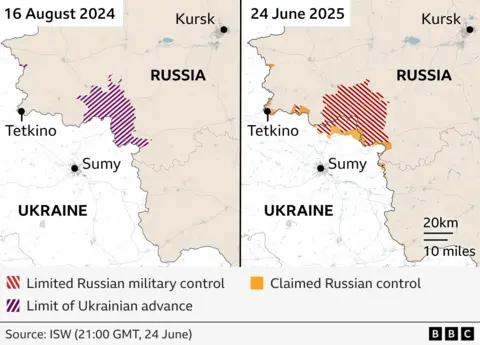
Ukraine has also struck air bases deep inside Russia, using 100 drones to target nuclear-capable long-range bombers.
It claimed the attacks resulted in $7bn (£5.2bn) of damage although those claims are not possible to verify.
The Russian Defence Ministry confirmed the attacks had occurred in five regions of Russia - Murmansk, Irkutsk, Ivanovo, Ryazan and Amur - but stated planes had been damaged only in Murmansk and Irkutsk, while in other locations the attacks had been repelled.
Ceasefire talks
The US, Ukraine's strongest military ally, has been pursuing an end to the war - now in its fourth year - through negotiation since Trump took office at the start of the year.
However, Zelensky and Trump have repeatedly clashed and tensions have been high since a heated confrontation at the White House in February during which Trump accused Zelensky of "gambling with World War Three" and chided him for not starting peace talks with Russia earlier.
By contrast, the US president has made efforts to improve relations with Moscow, although he did say he was "very angry" with Russia's President Vladimir Putin at the end of March after ceasefire talks between US and Russian officials stalled.
On 30 April the US and Ukraine signed a long-discussed deal to share profits from the future sale of Ukraine's mineral and energy reserves.
The deal aims to provide an economic incentive for the US to continue to invest in Ukraine's defence and reconstruction - as well as to address Washington's concerns over the amount of aid it has already contributed.
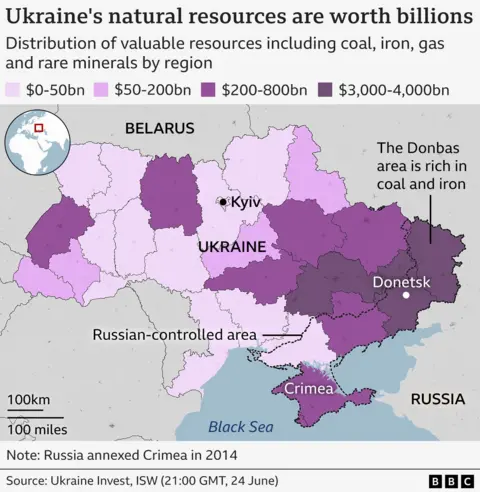
It will also see the establishment of an investment fund to spur Ukraine's economic recovery from the war.
After the deal was signed US Vice-President JD Vance said the war was "not going to end any time soon" and that the question facing the US administration now was how it could help Russia and Ukraine "find middle ground" to end the conflict.
Three years of fighting
Russia's full-scale invasion began with dozens of missile strikes on cities all over Ukraine before dawn on 24 February 2022.
Russian ground troops moved in quickly and within a few weeks were in control of large areas of Ukraine and had advanced to the suburbs of Kyiv.
Russian forces were bombarding Kharkiv, and they had taken territory in the east and south as far as Kherson, and surrounded the port city of Mariupol.
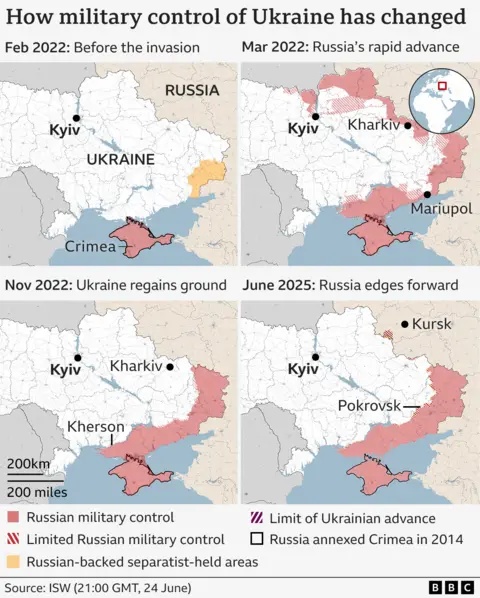
But they hit very strong Ukrainian resistance almost everywhere and faced serious logistical problems with poorly motivated Russian troops suffering shortages of food, water and ammunition.
Ukrainian forces were also quick to deploy Western supplied arms such as the Nlaw anti-tank system, which proved highly effective against the Russian advance.
By October 2022, the picture had changed dramatically and, having failed to take Kyiv, Russia withdrew completely from the north. The following month, Ukrainian forces recaptured the southern city of Kherson.
Since then, the battle has mostly been in the east of Ukraine with Russian forces slowly gaining ground over many months - military experts estimate between 165,000 and 235,000 Russian service personnel have been killed since the invasion.
Ukraine last updated its casualty figures in December 2024, when President Zelensky acknowledged 43,000 Ukrainian deaths among soldiers and officers. Western analysts believe this figure to be an under-estimate.
By Dominic Bailey, Mike Hills, Paul Sargeant, Chris Clayton, Kady Wardell, Camilla Costa, Mark Bryson, Sana Dionysiou, Gerry Fletcher, Kate Gaynor and Erwan Rivault
About these maps
To indicate which parts of Ukraine are under control by Russian troops we are using daily assessments published by the Institute for the Study of War with the American Enterprise Institute's Critical Threats Project.
The situation in Ukraine is often fast moving and it is likely there will be times when there have been changes not reflected in the maps.
